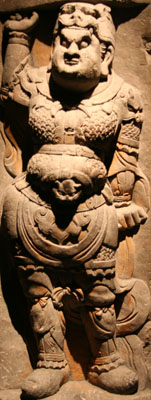Decorative Designs in Chinese Art 中国文物的纹饰
Carved Stone 石刻 Buddhist 佛教 Early Period 早期
Click on any word to see more details.
Buddhist 佛教
Early Period 早期
The relief statue below shows Sakyamuni Buddha 释迦牟尼佛, the historic Buddha. He is characteristically shown with Ananda 阿难 and Mahakassapa 摩诃迦叶, also spelled as Kasyapa, 大迦叶, two of his ten close disciples. The pedestal shows an incense burner and two lions. This is a scene representing the Buddha's first sermon and is repeated on a number different statues. Rocks and trees are carved in the stone on the background, representing Deer Park where the sermon took place.
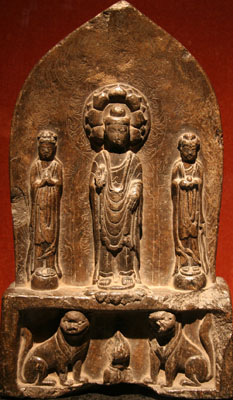
The statues above and below include a scenes describing jataka stories 本生, which are stories from the life or a past life of the Buddha. They originate in Indian Buddhist art. The relief carving here is a mural style on a flat surface. This type of relief sculpture is produced by a multi-step process. In the first step a painter paints the design on the stone. In the second step a mason chisels lines around the outlines. In the third step the painter may have painted the stone.

The statue below includes a large nimbus 背光 behind the Buddha. There are flame patterns 火焰纹 and floral patterns decorating the nimbus. Hand gestures or mudras 手印 are important Buddhist symbols. In the statue below the Buddhas right hand, facing outwards with five fingers pointing upwards, is an abhaya mudra 施无畏印. This indicates protection and assurance or casting out fear. The Buddhas left has is in a vara mudra 愿印, with his hand facing outwards with five fingers pointing downwards, indicating upholding of vows.
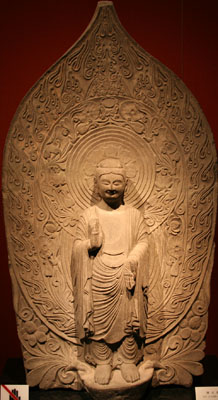
The statue below has surrounding decoration featuring two dragons arched over the Buddha, which is a traditional Chinese design. The relief in the statue below is much deeper and was created with a different technique.
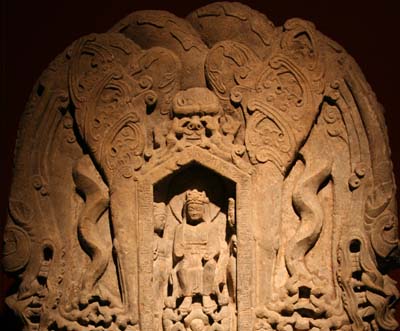
Large numbers implying nearly infinite quantities are common and important in Buddhism. The steele below is titled Ten thousand Buddhas Steele, not meaning ten thousand literally but a meaning a very large number. In China, ten thousand traditionally represents a large number or infinity. In Buddhist sutras this concept was represented by the number of grains of sand in the Ganges, the number of dust particles created by turning a world into dust (Lotus Sutra), the amount of space in a particular direction (Diamond Sutra), or other analogies.
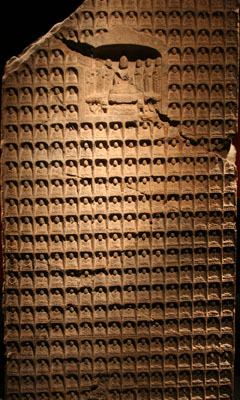
In Buddhism Lokapalas 天王 refer to the four heavenly kings, who are guardians of the four directions of the world. They are most frequently seen at temple entrances 山门. The Lokapala statue below is an Indian style figure.
Chinese
Pinyin English
